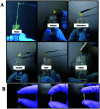High-performance water-borne fluorescent acrylic-based adhesive: synthesis and application
- PMID: 35518622
- PMCID: PMC9055326
- DOI: 10.1039/d0ra03782f
High-performance water-borne fluorescent acrylic-based adhesive: synthesis and application
Abstract
Water-borne adhesives have immense importance in cellulose-based materials, where their durability, handling, and strength remain to be a major concern. The present work demonstrates the development of three water-borne adhesives, namely, poly(1-vinyl-2-pyrrolidone-co-acrylic acid), poly(acrylonitrile-co-acrylic acid), and poly(1-vinyl-2-pyrrolidone-co-acrylonitrile-co-acrylic acid) applicable for cellulose-based materials. These acrylic-acid based adhesives were characterized by Fourier-transform infra-red spectroscopy, thermogravimetric analysis, X-ray diffraction, gel permeation chromatography, and universal testing machine. The synthesized polymer adhesives can be stored in the powder form for a longer period, thus utilizing less space. In order to use as adhesives, suitable formulations can be prepared in water. The adhesives show thermal stability up to 300 °C. Our studies show that poly(1-vinyl-2-pyrrolidone-co-acrylonitrile-co-acrylic acid) showed higher lap shear strength (ASTM D-906) than commercially available adhesives. In addition, these adhesives, being fluorescent in nature, can be detected under UV light and thus are applicable for the detection of fractured joints of any specimen. This property also helps in anti-counterfeiting applications, thus adding further to their utility.
This journal is © The Royal Society of Chemistry.
Conflict of interest statement
There are no conflicts to declare.
Figures












Similar articles
-
On the properties of nanosilicate-based filled dental adhesives: Synthesis, characterization, and optimized formulation.J Mech Behav Biomed Mater. 2021 Jul;119:104498. doi: 10.1016/j.jmbbm.2021.104498. Epub 2021 Mar 31. J Mech Behav Biomed Mater. 2021. PMID: 33839538
-
Bond durability of universal adhesive to bovine enamel using self-etch mode.Clin Oral Investig. 2018 Apr;22(3):1113-1122. doi: 10.1007/s00784-017-2196-x. Epub 2017 Aug 31. Clin Oral Investig. 2018. PMID: 28861744
-
Biophysical characterization of functionalized titania nanoparticles and their application in dental adhesives.Acta Biomater. 2017 Apr 15;53:585-597. doi: 10.1016/j.actbio.2017.01.084. Epub 2017 Feb 2. Acta Biomater. 2017. PMID: 28163237
-
Poly(acrylic acid) grafted montmorillonite as novel fillers for dental adhesives: synthesis, characterization and properties of the adhesive.Dent Mater. 2012 Apr;28(4):369-77. doi: 10.1016/j.dental.2011.11.010. Epub 2011 Dec 12. Dent Mater. 2012. PMID: 22169675
-
Novel Photoreactive Pressure-Sensitive Adhesives (PSA) Based on Acrylics Containing Additionable Photoinitiators.Materials (Basel). 2020 Nov 16;13(22):5151. doi: 10.3390/ma13225151. Materials (Basel). 2020. PMID: 33207630 Free PMC article.
References
-
- Barnes T. Pashby I. J. Mater. Process. Technol. 2000;99:72–79. doi: 10.1016/S0924-0136(99)00361-1. - DOI
-
- Zhang J.-t. Lu H.-n. Cao F.-q. J. Propul. Technol. 2008;29:13.
-
- Mittal K. L. and Pizzi A., in Handbook of Adhesive Technology, Revised and Expanded, CRC Press, 2003, pp. 9–20
-
- Delmonte J., Technology of adhesives, 1947
LinkOut - more resources
Full Text Sources
Research Materials

